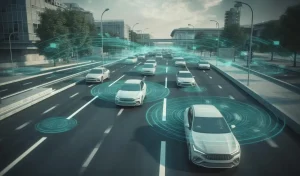
The rapid advancement of technology & automation has ushered in an era of innovation that is reshaping various aspects of our lives, including the way we move from one place to another. Self-driving cars, also known as autonomous cars, have emerged as a groundbreaking development in the automotive industry. While they hold the promise of revolutionizing transportation, a central question looms large: Are self-driving cars safe?
The Technology Behind Self Driving Cars
Self-driving cars, often referred to as fully autonomous vehicles, represent a significant leap in automotive technology. Companies like Tesla have been at the forefront of this innovation, introducing features such as “AutoPilot” and advanced driver assistance systems.
Self-driving cars are equipped with an impressive array of sensors, cameras, and artificial intelligence (AI) algorithms. These technologies work in concert to allow the vehicle to perceive its surroundings and make real-time decisions.
The sensors detect nearby objects, pedestrians, and other vehicles, while the AI processes this data to navigate the vehicle safely. This technology has the potential to significantly reduce accidents caused by human error, such as distracted driving or impaired judgment.
These technologies are paving the way towards fully autonomous vehicles that can navigate highways and city streets without human intervention. The promise of fully autonomous vehicles lies in their potential to enhance safety and reduce congestion on national highways.
However, as the dream of driverless cars becomes a reality, it also raises important questions about regulation and integration into existing highway traffic systems. The transition to a world with self driving systems is undoubtedly exciting, but it demands careful consideration of the challenges and opportunities they bring to our roadways.

Proudly Serving Duluth and All of Georgia Contact us to start your recovery! Explore Our Practice Areas

Are Self-driving Cars Safe? Can They Eliminate Human Errors that Often Contribute to Crashes
The accident rate of self-driving cars is a subject of ongoing research and scrutiny. It’s important to note that self-driving cars are a relatively new technology, and their deployment on public roads is still limited compared to traditional human-driven vehicles. As a result, accident data is continually evolving.
However, data from various sources, including autonomous vehicle companies and regulatory agencies, suggests that self-driving cars have a lower accident rate per mile driven when compared to human-driven cars. Proponents argue that autonomous vehicles can reduce accidents caused by human factors like distracted driving, impaired judgment, and speeding.
Nonetheless, it’s essential to interpret these statistics with caution, as self-driving cars are still in the testing and development phase. The technology must continue to improve to handle complex and dynamic traffic situations, adverse weather conditions, and other real-world challenges.
Benefits of Self-Driving Cars
One of the primary advantages of self-driving cars is their potential to enhance road safety. According to the World Health Organization, road traffic accidents are a leading cause of death globally. Self-driving cars have the capacity to reduce accidents by eliminating human factors that often contribute to crashes, such as speeding, drunk driving, and fatigue. These vehicles can maintain a constant awareness of their surroundings and react swiftly to potential dangers.
Click to contact our personal injury lawyers today

Problems with Self-Driving Cars
The problems facing self-driving cars can vary depending on perspective and region. However, some common challenges and concerns include:
- Regulatory Hurdles: Developing and implementing comprehensive regulations for self-driving cars is a complex and evolving process. Different regions and countries have varying rules and standards, which can create challenges for the widespread adoption of autonomous vehicles.
- Cybersecurity: Self-driving cars rely heavily on software and connectivity, making them vulnerable to cyberattacks. Ensuring the security of these vehicles and their communication networks is a significant concern.
- Public Trust: Gaining public trust in self-driving technology is essential. High-profile accidents involving autonomous vehicles, even if caused by human error, can erode public confidence and slow adoption.
- Infrastructure: The infrastructure, including road signage and communication networks, must evolve to support self-driving cars fully. Developing the necessary infrastructure can be a significant challenge.
- Cost and Affordability: The technology used in self-driving cars can be expensive, which may limit their accessibility to a broader range of consumers.

Complete a Free Case Evaluation form now
Safety Features in Self-Driving Cars
Self-driving cars are equipped with a robust set of safety features. These include adaptive cruise control, which automatically adjusts the vehicle’s speed to maintain a safe following distance. Additionally, collision avoidance systems can detect impending collisions and take evasive actions, such as applying brakes or steering away from danger. Emergency braking systems further enhance safety by rapidly decelerating the vehicle when a potential collision is detected.
Real-World Safety Data
To assess the safety of self-driving cars, it is essential to examine real-world data and statistics. Numerous studies and tests have been conducted to evaluate the performance of autonomous vehicles on the road. While no technology is entirely immune to accidents, the data consistently suggests that self-driving cars have a relatively low accident rate when compared to traditional human-driven vehicles. This data provides a compelling argument for the safety benefits of autonomous driving.

Ethical Considerations
As self-driving cars become more prevalent, ethical considerations come into play. Autonomous vehicles may encounter situations where they must make decisions that have ethical implications. For example, in a potential collision scenario, should the vehicle prioritize the safety of its occupants or pedestrians? These ethical dilemmas pose complex challenges and require careful consideration.
The Human Element
In the transition to a future where self-driving cars coexist with human-driven vehicles, understanding the dynamics between these two entities is essential. Human drivers must adapt to the presence of autonomous vehicles, and autonomous vehicles must anticipate the unpredictable behavior of human drivers. Effective communication between both types of vehicles is crucial for road safety.

Future Outlook
The future of self-driving cars is undeniably bright. As technology continues to advance, safety features will become even more sophisticated, further reducing the risk of accidents. Research and development efforts are ongoing, with the goal of refining the technology and addressing the remaining challenges. While complete autonomy may still be on the horizon, incremental improvements in safety are already being realized.
Conclusion
In conclusion, the question of whether self-driving cars are safe is multifaceted. The technology behind autonomous vehicles offers significant potential to enhance road safety by reducing accidents caused by human error. Safety features, real-world data, and ongoing research all point towards the safety benefits of self-driving cars.
However, ethical considerations, regulatory challenges, and cybersecurity concerns must be addressed as we move toward a future where self-driving cars become a common sight on our roads. As technology continues to evolve, the path to safer and more efficient transportation through self-driving cars appears increasingly promising.
FAQs
1. Are self-driving cars legal?
Self-driving cars are legal in many places but often require specific permits and comply with evolving regulations.
2. How do self-driving cars handle adverse weather conditions?
Self-driving cars use advanced sensors and data-sharing to navigate in adverse weather, but challenges remain in heavy rain, snow, and fog.
3. Can self-driving cars completely eliminate accidents?
While they can significantly reduce accidents, complete elimination is challenging due to unexpected road conditions and technical limitations.
4. What role do regulations play in the safety of autonomous vehicles?
Regulations set safety standards, liability rules, and testing requirements to ensure the safe development and operation of autonomous vehicles.
5. How can I stay safe while sharing the road with self-driving cars?
Stay informed about autonomous vehicle presence, follow traffic rules, maintain a safe following distance, and be prepared for unexpected situations.
For more information contact one of our Duluth car accident lawyers.
Call or text 404-951-3513 or complete a Free Case Evaluation form









